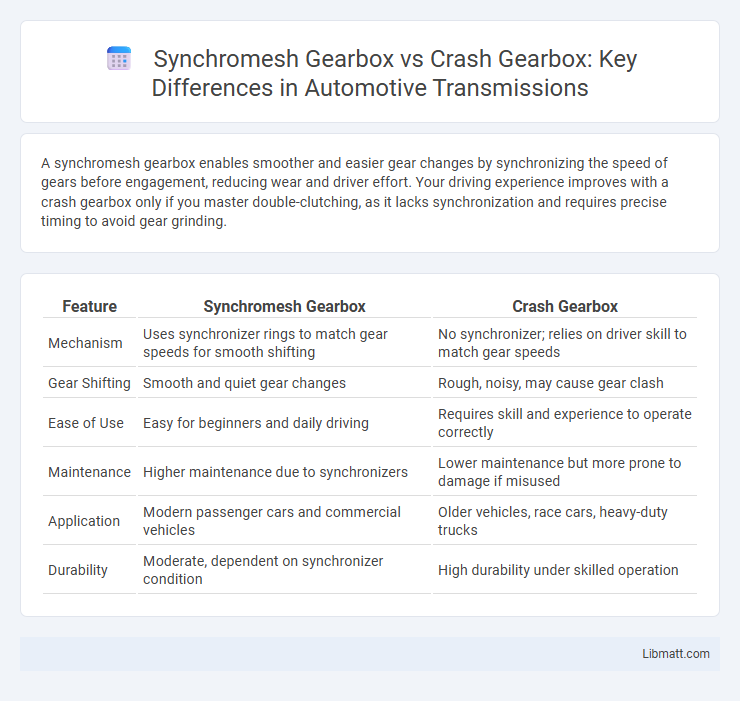A synchromesh gearbox enables smoother and easier gear changes by synchronizing the speed of gears before engagement, reducing wear and driver effort. Your driving experience improves with a crash gearbox only if you master double-clutching, as it lacks synchronization and requires precise timing to avoid gear grinding.
Table of Comparison
| Feature | Synchromesh Gearbox | Crash Gearbox |
|---|---|---|
| Mechanism | Uses synchronizer rings to match gear speeds for smooth shifting | No synchronizer; relies on driver skill to match gear speeds |
| Gear Shifting | Smooth and quiet gear changes | Rough, noisy, may cause gear clash |
| Ease of Use | Easy for beginners and daily driving | Requires skill and experience to operate correctly |
| Maintenance | Higher maintenance due to synchronizers | Lower maintenance but more prone to damage if misused |
| Application | Modern passenger cars and commercial vehicles | Older vehicles, race cars, heavy-duty trucks |
| Durability | Moderate, dependent on synchronizer condition | High durability under skilled operation |
Introduction to Synchromesh and Crash Gearboxes
Synchromesh gearboxes use synchronizer rings to match gear speeds for smooth shifting, reducing wear and driver effort. Crash gearboxes, also known as non-synchromesh gearboxes, require precise driver skill to manually match gear speeds, often resulting in grinding sounds during gear changes. Understanding the difference between synchromesh and crash gearboxes can help you choose the right transmission for your driving needs.
How Synchromesh Gearboxes Work
Synchromesh gearboxes operate by using synchronizer rings to match the speed of the gear to the shaft before engagement, allowing smooth and noise-free gear shifts. This system eliminates the need for double-clutching, reducing wear on gears and making driving more comfortable and efficient. Understanding how your synchromesh gearbox works can improve your vehicle's performance and extend the lifespan of your transmission components.
How Crash Gearboxes Operate
Crash gearboxes operate by directly engaging gears without synchronization, requiring drivers to manually match engine and gear speeds through techniques like double-clutching. This gearbox design lacks synchronizer rings, making gear shifts more challenging and prone to gear clash. Typically found in older or heavy-duty vehicles, crash gearboxes provide durability but demand greater skill to operate smoothly.
Key Differences Between Synchromesh and Crash Gearboxes
Synchromesh gearboxes feature synchronizers that match gear speeds for smooth, clash-free shifting, enhancing driving comfort and reducing wear. Crash gearboxes, also known as non-synchromesh, require precise double-clutching to avoid grinding since they lack synchronization mechanisms. The key difference lies in the presence of synchronizers in synchromesh systems, which simplify gear changes and improve drivability compared to the manual timing and skill needed for crash gearboxes.
Advantages of Synchromesh Gearbox
Synchromesh gearboxes provide smoother and quieter gear shifts by synchronizing the speeds of gears before engagement, reducing wear and tear. They enhance driving comfort and efficiency by eliminating gear clash and allowing quicker, more precise gear changes. Maintenance costs are typically lower due to reduced mechanical stress compared to crash gearboxes.
Benefits of Crash Gearbox
Crash gearboxes offer a simpler, more robust design that reduces manufacturing complexity and maintenance costs, making them ideal for heavy-duty or vintage vehicles. Their direct gear engagement eliminates the need for synchronizers, enabling quicker and more positive gear shifts under extreme conditions. This mechanical simplicity enhances durability and reliability in harsh environments, where synchromesh mechanisms might fail or wear out prematurely.
Applications in Modern and Classic Vehicles
Synchromesh gearboxes are commonly used in modern vehicles due to their smooth gear shifts and reduced wear, enhancing driving comfort and efficiency. Crash gearboxes, often found in classic and vintage cars, require precise driver skill to match gear speeds without synchronization, preserving the authentic driving experience. Your choice depends on whether you prioritize modern convenience or the traditional mechanical challenge in vehicle operation.
Maintenance and Longevity Comparison
Synchromesh gearboxes require less frequent maintenance due to their smooth gear engagement mechanism, reducing wear on internal components and extending overall lifespan. In contrast, crash gearboxes demand more regular adjustments and repairs because the driver must manually match gear speeds, increasing the risk of gear grinding and accelerated component wear. Consequently, synchromesh gearboxes offer superior longevity and lower maintenance costs compared to crash gearboxes in modern vehicles.
Driving Experience: Synchromesh vs Crash Gearbox
Synchromesh gearboxes provide a smoother driving experience by automatically matching gear speeds during shifts, reducing gear clash and making it easier for drivers to change gears seamlessly. Crash gearboxes require precise clutch control and double-clutching to align gear speeds manually, often resulting in noisy and challenging shifts, especially for inexperienced drivers. The advanced synchronization in synchromesh systems enhances comfort and drivability, making them preferred in modern vehicles over the mechanically demanding crash gearboxes.
Which Gearbox Is Right for You?
Choosing between a synchromesh gearbox and a crash gearbox depends on your driving experience and vehicle use. A synchromesh gearbox offers smoother gear shifts and is ideal for everyday driving, reducing wear and providing greater comfort, while a crash gearbox suits those who prioritize mechanical simplicity and direct gear engagement, often favored by vintage car enthusiasts or in racing scenarios. Your decision should consider ease of use and maintenance, as the synchromesh is more user-friendly, whereas the crash gearbox demands precise timing and skill.
Synchromesh Gearbox vs Crash Gearbox Infographic

 libmatt.com
libmatt.com